Social stories are valuable tools in supporting the development of social and emotional skills in neurodiverse children. They are brief stories that describe social situations or interactions, breaking down complex scenarios into simple, clear steps that children can understand. Social stories can be used to support children with understanding emotions, learning new skills, navigating complex social challenges, problem solving, and adjusting to life changes and transitions.
Social stories can be particularly beneficial for children with autism spectrum disorder (ASD), as well as with other developmental disorders and mental health conditions, such as attention deficit hyperactivity disorder (ADHD), Intellectual Disability, Anxiety, and Learning Disabilities. Neurodiverse children can have unique challenges in their day-to-day functioning. Skills that neurotypical children may develop naturally may be very effortful for neurodiverse children, and this is where the scaffolding for social stories come into play. These tools are used to break down complex social situations and learnings into simple steps, to guide neurodiverse children in building their skills and capacity that will help them with day-to-day functioning.
Known benefits of social stories:
- Improve Social Communication Skills by breaking down complex social situations into simple, manageable steps. By offering a clear framework for understanding social interactions, social stories can help children with ASD and other developmental disorders learn how to communicate more effectively with others. For example, a social story might describe how to initiate a conversation with a new peer, providing step-by-step instructions on how to approach someone, introduce oneself, and ask a question. By reading and internalising these stories, children can improve their social skills and feel more confident in social situations.
- Reduce Anxiety and Improve Emotional Regulation. Neurodiverse children can experience anxiety and difficulty regulating their emotions in social situations. Social stories can help alleviate these challenges by providing children with a clear understanding of what to expect in social situations. By knowing what is expected of them, children are more likely to feel confident and less anxious in social situations.
- Help neurodiverse children develop empathy and an understanding of others. These stories can present different perspectives and explain the feelings and thoughts of others, social stories can help children develop their understanding of social interactions. By developing an understanding of others' perspectives and emotions, children can improve their ability to communicate and interact with others.
- Help neurodiverse children improve their problem-solving skills by presenting hypothetical scenarios and providing strategies for addressing them. Through presenting different options and explaining the pros and cons of each, social stories can help children develop critical thinking skills and problem-solving abilities. For example, a social story might describe a conflict between two peers and provide strategies for resolving the conflict in a constructive way. By internalising these strategies, children are better equipped to handle similar situations in the future.
- Help neurodiverse children develop self-awareness and self-esteem by presenting positive models of behaviour and highlighting their own strengths and abilities. By presenting positive and affirming messages, social stories can help children develop a more positive self-concept and feel more confident in social situations. For example, a social story might describe a child's unique strengths and talents and highlight the importance of being true to oneself.
When can you use a social story:
Social stories can be an amazing way to help neurodiverse individuals better understand and navigate social situations.
Social stories can be a useful tool for many different situations and hold benefit for both neurotypical and neurodiverse populations. Think of it as a cheat sheet for children to help them understand some of the more challenging or complex skills they need to learn.
Social stories can be used to help children develop skills in many different areas, for example:
- Self-care or functional skills such as cleaning teeth, washing hands, or catching the school bus.
- Adjusting to life transitions and changes such as moving houses, losing a grandparent, or getting a sibling.
- Developing social skills such as sharing, conflict resolution and managing bullies in the playground.
- Understanding emotions and emotion regulation strategies such us recognising and responding to anger.
- Building empathy for others, through helping explain how others might feel or react in a certain situation.
- Managing challenging behaviours such as risk-taking behaviours, sensory seeking behaviour or aggression.
Who can create a social story:
Social stories are clear, concise narratives that break down complex social situations and learning into simple steps. Like a “how to guide” for children that can help build a child’s skills and capacity. They can be created by Allied health professions or by parents, carers, or teaching staff.
If you are looking for support with creating a social story for your child you can seek out trained allied health professionals such as psychologists, speech therapists, or occupational therapists. Trained professionals can support in identifying the goal of the social story, while taking into consideration the unique needs of your child to determine the most effective way of communicating the information and skills that they will need to learn.
How to create a social story:
The first important step when making a social story for a neurodiverse child is to identify the specific goal, is there a specific social situation or behaviour that you want to address/target. The specific goals could be going to a friend’s house, dealing with a change in morning routine, or understanding appropriate behaviours in a public setting. Having a clear goal will help you create a personalised story or “how to guide” that meets the specific needs and experiences of your child. Social stories are most effective when they are highly individualised to each child’s needs and their setting, this can be done by tailoring the breakdown of steps to the level of support your child needs and ensuring the text and image match their experiences.
When creating or telling the story, make sure it is simple and short. Use clear and concise language and stick to the key points you would like to communicate, avoid getting into too much depth in the social story. Short and concise social stories will help keep your child’s attention and makes it easier for them to remember the content.
Where possible make the social story collaboratively with your child. This can be done to varying degrees, such as researching the topic and creating a plan together or writing the story and getting your child to glue the photos in place. Allowing them to feel involved in the process will help them build a positive association with the story.
Social stories can be made using many different mediums, working collaboratively with your child to choose the most engaging medium for them. For example, you can create social stories on PowerPoint presentations, written books, comic strips or videos. It is important to always incorporate visual support alongside the written stories, this will make the stories more engaging, and easier to understand and remember.
Repetition is a very important key for social stories. Once it is created it is important for a safe person to practise reading the social story with your child and use these moments as an opportunity to further discuss the content. While reading the social stories you can ask curious questions, reflect on emotions, or offer your own perspective or experiences. Reading the social story should always be a positive experience and can be paired with positive one-on-one time with an adult. Building a positive association with the story will help internalise the content and learnings. If a social story is created to help with navigating a new or challenging situation it can be useful to keep a copy of the social story with your child as a reference to guide them.

We've tailored the services at RWA Pyschology - Family Matters to all age groups from young children to adolescents and adults - and we have specialists in crisis, short/medium term counselling and longer term psychotherapy.
Call RWA psychology for an appointment with one of our psychologists.
